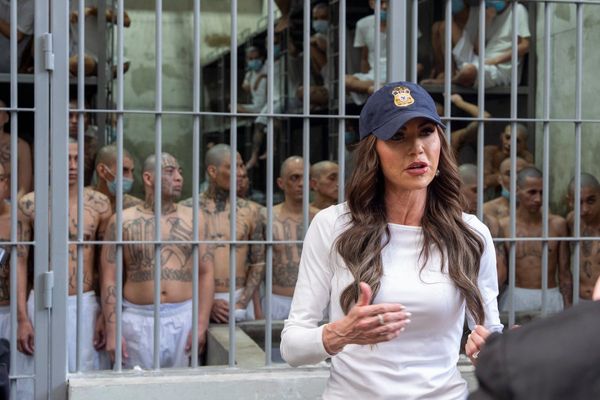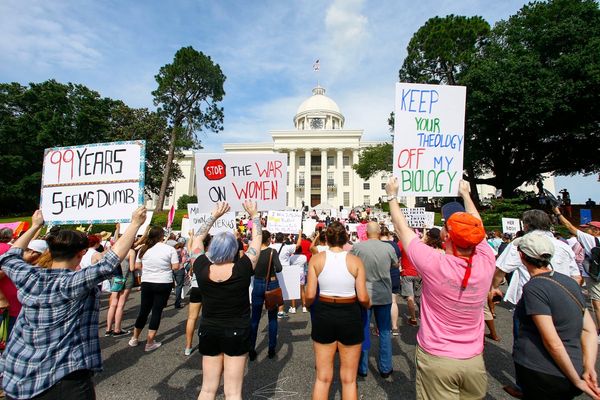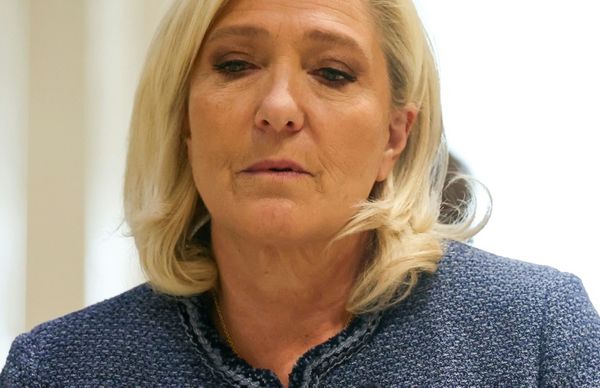When Tiffany Blount started competing in indoor rock climbing a few years ago, she was often the only Black woman at the contests. “It was awful,” Blount said.
Fellow competitors were sometimes unhelpful, Blount recalled, claiming that they didn’t see her finish a climb. (Witness signatures are needed to verify attempts.) Another time, a gym manager told her that she couldn’t complete a route because she wasn’t strong enough. Blount’s frustration mounted. Enduring what she characterized as repeated microaggressions took a toll on her.
So in March 2020, Blount, who is 42 and based in New Jersey, launched Black Girls Boulder, a social climbing club that hosted meet-ups in New York and New Jersey. Then a couple of years later, she led the first Blk Out Fest in Chattanooga, Tennessee, where Black climbers gathered to train, camp, watch films featuring Black athletes and share vulnerable conversations about climbing while Black.

It was a healing space that they didn’t know they needed. “People will tell you, ‘It’s not even about climbing … I don’t have to code-switch. I can literally just be,’” Blount said of the festival’s attendees.
As a white male-dominated sport, indoor and outdoor climbing can be complicated for Black and brown athletes. Indoor climbing gyms, where many get their start at a young age, are mostly located in affluent communities, said Aman Anderson, a climbing coach and founder of Beast Fingers Climbing in north Denver, Colorado. The costs of gear, gym memberships and contest fees can also be prohibitive. (Next year, USA Climbing – the national governing body of competition climbing – plans to provide scholarships to climbers who can’t afford to participate in competitions, according to its CEO, Marc Norman.)
Many climbers of color face other barriers to entry such as lack of access to national parks, or they’re exposed to racism while climbing, such as derogatory names of public routes. They must also contend with a history of deliberate exclusion from the outdoors.

But in recent years, Black and brown athletes have been changing the face of climbing by offering safe spaces for underrepresented climbers to learn, heal from discrimination and participate in community. From pushing for institutional change to founding their own organizations, these athletes are creating opportunities for the next generation of climbers that they hope will be more diverse.
A history of exclusion
Climbing is historically known as a white sport because of its roots in exclusionary and discriminatory policies that affected people of color. When the National Park Service was created in 1916, Black people were segregated or excluded from entering public lands including state and national parks. Integration efforts were usually met with violence.
“The underlying rationale for creating parks was this idea of US nationalism, to promote the American identity, and the American identity was primarily white, male and young,” Myron Floyd, dean of the College of Natural Resources at North Carolina State University, told the school’s publication in 2020.
Throughout the nation, many Indigenous people were forced off their homelands as the borders of national parks were being drawn. John Muir, founder of the environmental advocacy group Sierra Club – and also known as the father of the national park system – wrote in his 1894 book The Mountains of California that the Mono people, a tribe whose presence in the Sierra Nevada mountains and the surrounding area dates back thousands of years, had “no right place in the landscape”.
The segregation of recreational sites largely continued until the Civil Rights Act of 1964, which banned the practice. But the legacy of discrimination has continued to affect national park visitation to this day: according to a 2018 report, Latino and Asian Americans each made up less than 5% of national park visitors, while Black visitors comprised less than 2%.

Despite that historical lack of access, Black and brown climbers have a rich – and often unknown – legacy of participation in the sport. Brown Girls Climb, a non-profit that hosts climbing meet-ups for women and non-binary people of color across the country, incorporates that untold history in its programming. The group’s executive director, Brittany Leavitt, said that she and her team use storytelling at meet-ups, on Instagram and on their app to highlight first ascenders such as Chelsea Griffie, the first Black woman to climb El Capitan in Yosemite.
“We’re creating that data that there have been folks doing this before us and now we’re this new generation of those who are trying to create more space,” said Leavitt, a 34-year-old climber based in New York City.
Once approved to join the app, members can share resources on where it’s safe for Black and brown people to stay or eat when climbing in mostly white, rural areas. Leavitt sees such online communities as offering safety, similar to the Green Book which listed lodgings and businesses that would serve Black motorists during the Jim Crow era.
She’s also helping climbers improve their skills. Last summer, Brown Girls Climb helped organize the inaugural United in Yosemite, a five-day climbing festival hosted by the Yosemite national park and the American Alpine Club, with support from Yosemite Conservancy. During the event, the group held an introductory workshop on rock climbing. The festival was core to the group’s ethos. Discussing the legacy of climbers of color, Leavitt mentioned how Indigenous people of Yosemite climbed the surrounding mountains for ceremonial purposes.
Creating pipelines
Because of the lack of representation in climbing, there’s a stigma that “that’s a white people thing; it’s just not for us”, said Kai Lightner, a 24-year-old professional climber from Fayetteville, North Carolina.
That didn’t stop Lightner, whose urge to climb at six years old brought him to the top of a 50-foot flag pole when his mother wasn’t watching. After school the next day, he joined the local climbing gym at the encouragement of a passerby who watched his ascent. But he didn’t encounter another Black climber at competitions until a decade later, when he met the professional climber and host of HBO’s reality series The Climb, Meagan Martin.

As a means to diversify the industry, Lightner created the non-profit Climbing for Change in July 2020 to provide grants – such as an average of $1,200 to cover program fees and travel costs to climb outdoors and up to $3,600 for a climbing instructor certification – as well as to consult with climbing organizations.
In Georgia, the non-profit partnered with the city of College Park to build a climbing wall at the Tracey Wyatt recreation center. And Lightner worked with local climbing gym, Stone Summit, to provide free bussing from the recreation center to the gym, along with subsidised or free entry for those who can’t afford a membership. It’s a model that Lightner and his team hope to replicate elsewhere, he said, “to create these sustainable pipelines to get these kids into climbing and make the sport more diverse”.
He recently expanded his work to Jamaica, where he convinced his sponsor Adidas to fund the creation of a climbing wall in the national stadium. While there last month, he completed his first ascent of a route that he named If You’re Tall, due to his 6ft 3in height. It was significant for Lightner, who can’t recall many climbs that were first ascended by Black or brown climbers.
In outdoor rock climbing, the first person to map out and complete a route has the privilege of naming it. Many routes in the US notoriously have racist or obscene names, including the Slavery Wall in Wyoming, or Trail of Tears in California.
Offensive route names gained attention amid calls for racial justice in 2020. “All of a sudden, people would go to the crag [a rock face] and see this horrendously named route and say, ‘Wow, that is whack,’” said Taimur Ahmad, a 30-year-old climber and former fellow at the climbing advocacy organization Access Fund.

In a 2020 survey from the outdoor industry magazine SNEWS, 91% of respondents said that they had encountered route names that they considered racist. Some of those names have since been changed by guidebook authors and local climbing organizations, but Ahmad has found that the movement to change offensive route names has mostly petered out.
Ahmad, who is half Pakistani and half Jewish, has provided guidance on more inclusive route naming in trade magazines. And along with other climbers of color, he has used his first ascents to highlight historical figures. He named a route in California’s eastern Sierra mountains al-Shatir after the 14th-century Muslim astronomer. And Blount named a route in Colorado Patterson’s Pitch in honor of Mary Patterson, the first Black woman in the US to earn a college degree.
Looking to the future generation
For Anderson, the Beast Fingers Climbing gym founder, the key to diversifying the industry is in creating climbing gyms in low-income communities of color. Anderson, who is 36, also trains youth to become competitive climbers through the USA Climbing team.
“There’s so much talent out there,” Anderson said. “But if we’re not in their backyard, how would you find them?”
Beast Fingers, one of the only Black-owned indoor climbing gyms in the country, has made a difference for 14-year-old Gabriel Regueiro-Prosch, who hopes to compete in the Olympics someday. As a Latino climber, he often feels out of place among the mostly white youth at competitions. It’s a stark difference from his gym, where he is surrounded by other youth of color.
“It makes me feel more included,” Regueiro-Prosch said of the gym. “We can relate more and it makes me feel better about myself.”







